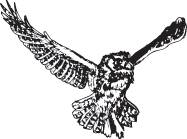

Hawk facts
Three very important things to remember about hawks are:
- Hawks have hooked beaks that they use to cut up their food.
- Hawks, like all birds, have very good eyesight. They can see eight times better than humans. Hawks are able to see colors.
- Hawks have powerful scale-covered feet with very sharp talons that they use to kill their prey. They stand with three toes forward and one toe backwards.
Other important things about hawks:
- Most hawks are diurnal (they are active during the day). Some hawks are crepuscular (they are active early in the morning during dawn and late in the day at dusk).
- Hawk's eyes are on the sides of their heads. This allows them to see almost all of the area around them (280 degrees). They have a limited area of depth perception (20 degrees).
- We think large hawks and eagles are able to see a rabbit at a distance of two miles.
- Hawks use their excellent eyesight, fast flight speed and powerful scale-covered feet to catch their prey.
- Peregrine falcons and golden eagles can dive as fast as 200 miles per hour when they are pursuing prey.
- Most hawks migrate. They ride on thermals, the warm updrafts that occur over land.
- Most hawks are opportunistic feeders. They will eat whatever they can catch. They will eat insects, toads, frogs, snakes, mice, voles, rats, shrews, chipmunks, and even other birds.
- Hawks use their feet to hold the dead prey and use their beaks to tear off pieces of the prey. They swallow and store the pieces in their crops. This allows them to eat very fast and get up off the ground into the air where they are safe.
- While hawks eat, they mantle over their food. This means that they hide the food with their outstretched wings and tail.
- The next day after eating, hawks cough up a pellet that contains only the fur or feathers of the animals that they ate. Hawks usually do not swallow the larger bones and the smaller bones are digested by their strong stomach juices.
- Hawks make stick nests which they keep clean so they don't attract predators that might eat their eggs or young. Most hawks line their nest with evergreen branches which may help discourage flea and lice parasites.
- New York State hawks can weigh up to three pounds and have a wingspan of up to four and a half feet.
- There are about 14 different kinds -- species -- of hawks and eagles that live and nest in New York State.